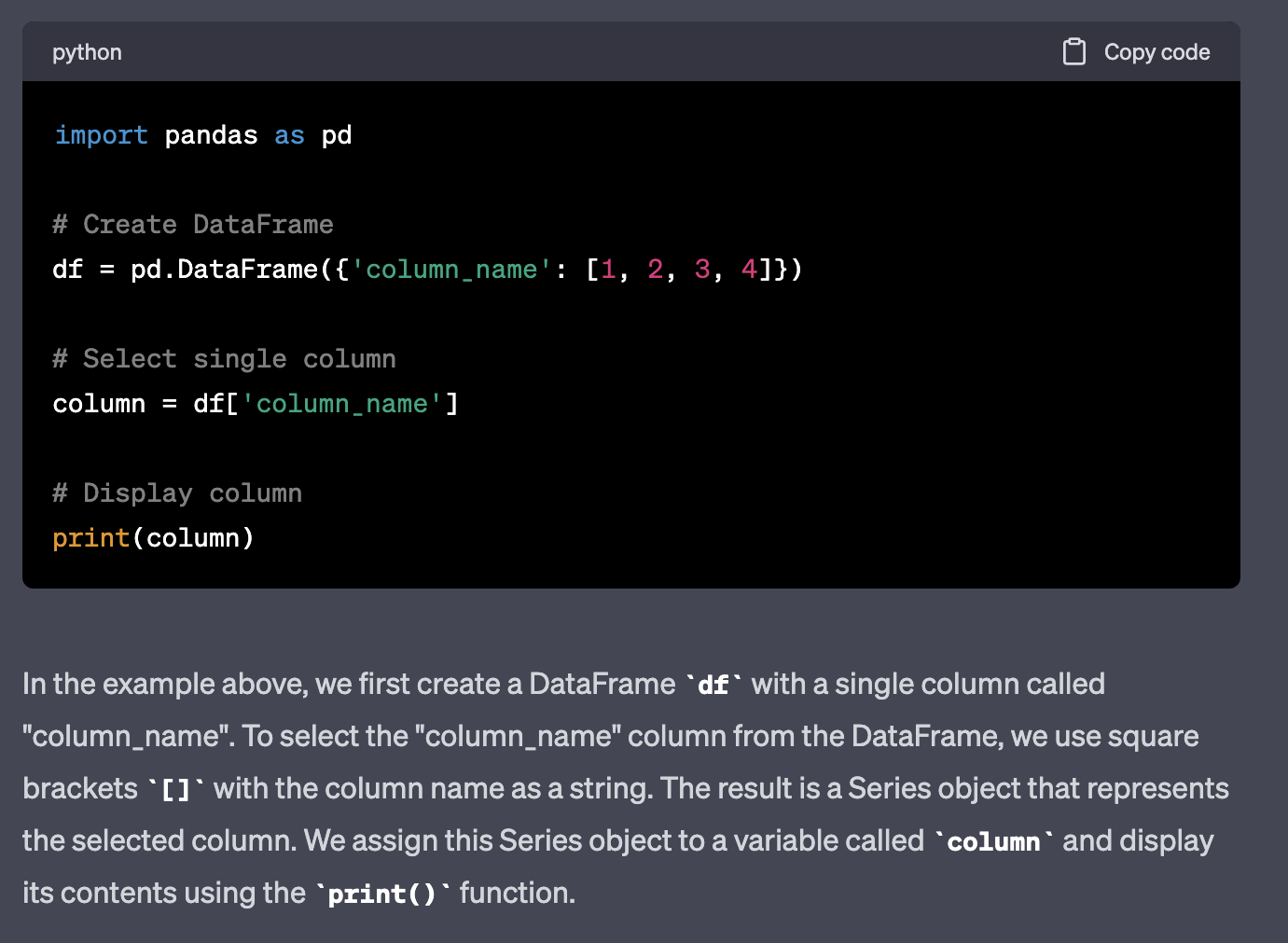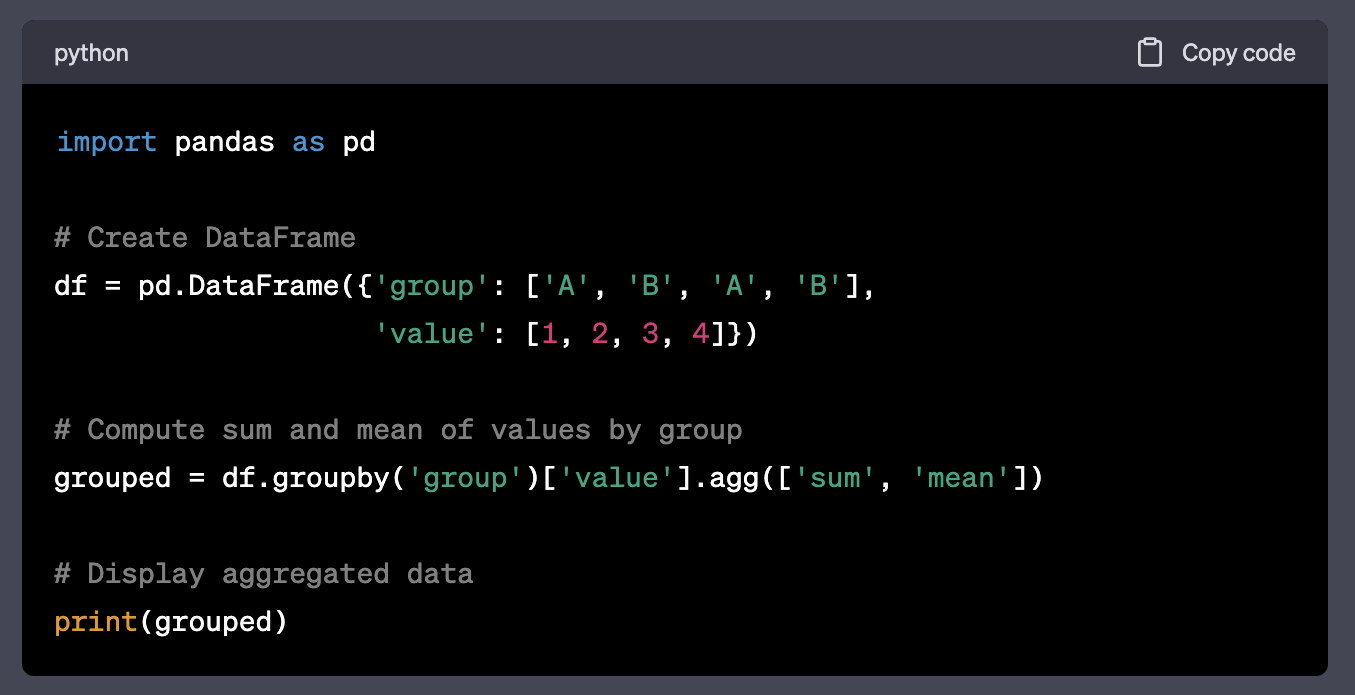Hacks for Student Lesson 4/27
Following along the student created lesson plan.
- Panda hacks
- 1. What are the two primary data structures in pandas and how do they differ?
- 2. How do you read a CSV file into a pandas DataFrame?
- 3. How do you select a single column from a pandas DataFrame?
- 4. How do you filter rows in a pandas DataFrame based on a condition?
- 5. How do you group rows in a pandas DataFrame by a particular column?
- 6. How do you aggregate data in a pandas DataFrame using functions like sum and mean?
- 7. How do you handle missing values in a pandas DataFrame?
- 8. How do you merge two pandas DataFrames together?
- 9. How do you export a pandas DataFrame to a CSV file?
- 10. What is the difference between a Series and a DataFrame in Pandas?
- Data Analysis + Predictive Analysis
- 1. How can Numpy and Pandas be used to preprocess data for predictive analysis?
- NumPy and Pandas are powerful libraries that can be used to preprocess data for predictive analysis.
- 2. Can you explain the process of building a handwriting recognition system using TensorFlow?
- 3. What machine learning algorithms can be used for predictive analysis, and how do they differ?
- 4. Can you discuss some real-world applications of predictive analysis in different industries?
- 5. How can Numpy and Pandas be used to manipulate and filter data for more accurate predictions?
- 6. What are some challenges associated with handwriting recognition, and how can they be overcome?
- 7. Can you explain the role of feature engineering in predictive analysis, and how it can improve model accuracy?
- 8. How can machine learning models be deployed in real-time applications for predictive analysis?
- 9. Can you discuss some limitations of Numpy and Pandas, and when it might be necessary to use other data analysis tools?
- 10. How can predictive analysis be used to improve decision-making and optimize business processes?
Panda hacks
1. What are the two primary data structures in pandas and how do they differ?
The two primary data structures in pandas are Series and DataFrame. A Series represents a single column of data, while a DataFrame represents a whole table of data with rows and columns. A DataFrame is like a Series of objects, where each Series represents a column in the DataFrame, and the row labels are shared between all the columns. Also, a DataFrame can perform operations that are not possible with a Series, such as joining or merging multiple tables, and grouping data based on certain criteria.
2. How do you read a CSV file into a pandas DataFrame?
You use the read_csv() function.
3. How do you select a single column from a pandas DataFrame?
You can use square brackets [] with the column name as a string.
Here is an example from chat gpt since my pandas does not work:

4. How do you filter rows in a pandas DataFrame based on a condition?
You can filter rows in a pandas DataGrame by using the function df_filtered and setting it to the way you want to sort it.
5. How do you group rows in a pandas DataFrame by a particular column?
You group rows in pandas DataFrame by a particular name by adding them to a group such as the code used in your lesson: age_groups.
6. How do you aggregate data in a pandas DataFrame using functions like sum and mean?
Aggregating data can be done through DataFrames using sum and mean by using the groupby() function and aggregating it after.
Here is an example from chatgpt:

7. How do you handle missing values in a pandas DataFrame?
Missing values in a pandas DataFrame can be handled using various methods.
8. How do you merge two pandas DataFrames together?
You can merge two pandas DataFrames together using the merge() function. The merge() function combines DataFrames based on one or more common columns, called keys.
9. How do you export a pandas DataFrame to a CSV file?
You can export a pandas DataFrame to a CSV file using the to_csv() function. The to_csv() function writes the DataFrame to a comma-separated values (CSV) file.
10. What is the difference between a Series and a DataFrame in Pandas?
In Pandas, a Series is a one-dimensional labeled array that can hold any data type, while a DataFrame is a two-dimensional labeled data structure with columns of potentially different data types.
Data Analysis + Predictive Analysis
1. How can Numpy and Pandas be used to preprocess data for predictive analysis?
NumPy and Pandas are powerful libraries that can be used to preprocess data for predictive analysis.
2. Can you explain the process of building a handwriting recognition system using TensorFlow?
no, this part was really confusing.
3. What machine learning algorithms can be used for predictive analysis, and how do they differ?
4. Can you discuss some real-world applications of predictive analysis in different industries?
A real-world application of predictive analysis in different industries is the shopping industry, people can predict what new trends will be baased off of from the recent buys or trends within the fashion industry.
5. How can Numpy and Pandas be used to manipulate and filter data for more accurate predictions?
Numpy and Pandas can be used to clean data by identifying and removing missing values, outliers, and other data inconsistencies. This can help to reduce noise in the data and ensure that the predictive model is trained on high-quality data. Numpy and Pandas can be used to filter data based on specific criteria, such as selecting data from a particular time period or location. This can help to ensure that predictive models are trained on relevant data.
6. What are some challenges associated with handwriting recognition, and how can they be overcome?
Bad handwriting can be hard to detect however training a algorithm to recognize pepole’s handwriting by having them write the way they specific write letters will train the algorithm to detect their handwriting.
7. Can you explain the role of feature engineering in predictive analysis, and how it can improve model accuracy?
The role of future engineering in predictive analysis is going to be predicting the realiability rates of new models such as flight simulators. It can improve model accuracy by predicting the rates at which how well a model is going to perform.